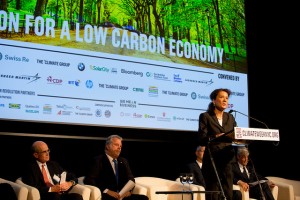Lisa Manley is a Corporate Social Responsibility Executive with Edelman, one of the largest Public Relations firms. She has 20 years of experience in global sustainability strategy and engagement, and recently offered “Five Observations from UN Climate Week.” It gives us a bird-eye view of the outcomes from a business point of view.
Manley was inspired by all the events that took place over a week ago, including the People’s Climate March that drew more than 300,000 environmental activists. She acknowledges how lackluster the outlook has been since 2009’s disappointing climate conference in Copenhagen but points out several take-aways from this year’s Summit in New York, suggesting high hopes for the UN Framework Convention on Climate Change (UNFCCC) in Paris next year. “Optimism is on the rise,” is her perspective.

Flickr/creative commons
Manley asserts “partnership is the new leadership” by citing promising new collaborations of businesses and governments, such as We Mean Business and RE100, and The World Bank global efforts building a coalition among businesses and governments to support carbon pricing.
Manley goes on to say that “business has new and compelling voices in the dialogue” noting that 100 CEOs attended this year’s Summit. She highlights Apple’s Tim Cook who believes that innovation induces economic growth, particularly in the area of renewable energy.”
“Our cities are likely where the change happen fastest,” says Manley, believing that as we look forward to Paris’s UNFCCC next year the focus will shift from nation states to what can be accomplished by major cities.
The world’s architects are leading the way with impressive commitments to reduce energy consumption and greenhouse gas emissions (GHGe) of urban areas by changing how buildings and cities are planned, designed and constructed. For instance, at the International Union of Architects (UIA) World Congress in August 2014, member organizations representing over 1.3 million architects in 124 countries unanimously adopted the 2050 Imperative — a declaration to eliminate CO2 emissions in the built environment by 2050. This is a significant commitment, considering urban areas generate 70 percent of all GHGe, mostly from buildings. Looking ahead to 2035 (and accounting for population growth and expected human migration), 75 percent of the built environment will be either new or renovated.
Manley concludes, “communication and engagement are critical as we continue to pave the path forward.” She brings to our attention an inspirational film shown to world leaders at the opening of the UN Summit, WHAT’S POSSIBLE, demonstrating that “climate change is solvable — but engagement and action are essential.” She notes that “two years ago, the NYC climate summit sparked 1 million social shares, last year it was 2 million and this year it was 83 million!
Continuous dialogue, commitments and follow-through will be crucial to motivate citizens and stakeholders as we build alignment by mid-century around paths for zero emissions. This week certainly provided a vital spark of optimism that we must maintain to achieve the success needed at climate summits in Lima, then in Paris and beyond. The impacts, challenges and opportunities of climate change are evolving in the hearts and minds of citizens around the world, opening doors of opportunity for continued communication and engagement.
Full article available here. Talk to your family and friends and the business you work for. Find out what you can do in your own community to make it greener. Redouble your efforts to reverse the destruction of planet earth. Okay?
